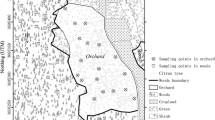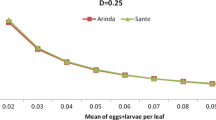Abstract
We developed a new method for monitoring pests over a growing season and applied the method to monitoring the European red spider mite (Panonychus ulmi Koch) in apples. We evaluated the performance of the monitoring method in this system by simulation experiments and a field test in 28 orchard blocks in New York State, USA in 1995. The method is based on serially linking sample occasions (bouts) in time. At each sample bout, the monitoring procedure decides between intervening or not intervening. In the case of no intervention, the procedure schedules the next sample bout on the basis of an estimate of the current density, a descriptive population growth model (exponential for mites) and intervention thresholds. The next sample bout is scheduled when the risk of the pest density becoming greater than a future intervention threshold exceeds a specified tolerance. The name of the sampling method reflects this adaptiveness of the sampling frequency. The sampling protocol is constructed by combining a sequential probability ratio test for taking time-efficient invervention decisionsat high density with a fixed sample size estimation at low density. The low-density estimates are used for calculating the waiting times until the next sample. The probabilities of the intervene or wait decisions and the expected sample sizes for these sampling protocols were calculated as functions of the pest density by Monte Carlo simulation. The expected performance characteristics of the monitoring method for a given population trajectory are estimated by integrating the performance criteria of the sampling protocols over a population trajectory. We simulated the performance of the monitoring method for two sets of 400 simulated population trajectories. The trajectories were calculated with an exponential polynomial equation with random parameters. The trajectories in the first set were characterized by low growth rates and a maximum density below the intervention threshold while the trajectories in the other set had high growth rates and a maximum density above the threshold. As performance criteria we used the probability of intervening, the number of scheduled sample bouts, the total number of sample units, the cumulative mite density per leaf (mite days) and the mite density at the time of intervention. Simulation indicated that the adaptive frequency classification would have similar performance characteristics to existing monitoring methods when monitoring rapidly growing populations, while substantial savings on the number of sample bouts would be expected with slowly growing populations. The field test confirmed these predictions and demonstrated the savings on sample bouts that are obtained by using the adaptive frequency classification.
Similar content being viewed by others
REFERENCES
Baillod, M., Antonin, Ph., Guignard, E. and Jermini, M. 1989. Vers une généralisation de la lutte biologique contre les acariens phytophages en vergers de pommiers. Rev. Suisse Viticult. Arboricult. Horticult. 21: 279–284.
Binns, M.R. 1994. Sequential sampling for classifying pest status. In Handbook of sampling methods for arthropods in agriculture, L.P. Pedigo and G.D. Buntin (eds), CRC Press, Boca Raton, FL. pp. 138–173.
Binns, M.R. and Nyrop, J.P. 1992. Sampling insect populations for the purpose of IPM decision making. Ann. Rev. Entomol. 37: 427–453.
Binns, M.R., Nyrop, J.P. and van der Werf, W. 1996. Monitoring pest abundance by cascading density classification. Am. Entomol. 42: 113–121.
Entwistle, J.C. and Dixon, A.F.G. 1986. Short-term forecasting of peak population density of the grain aphid (Sitobion avenae) on wheat. Ann. Appl. Biol. 109: 215–222.
Fowler, G.W. and Lynch, A.M. 1987. Sampling plans in insect pest management based on Wald's sequential probability ratio test. Environ. Entomol. 17: 345–354.
France, J. and Thornley, J.H.H. 1984. Mathematical Models in Agriculture, pp. 75–94. Butterworths Publishers, London.
Nyrop, J.P. and Binns, M.R. 1991. Quantitative methods for designing and analyzing sampling programs for use in pest management. In Handbook of pest management in agriculture, 2nd edn, Vol. II, D. Pimental (ed.), pp. 67–132. CRC Press, Boca Raton, FL.
Nyrop, J.P. and Binns, M.R. 1992. Algorithms for computing operating characteristic and average sample number functions for sequential sampling plans based on binomial count models and revised plans for European red mite (Acari: Tetranichidae) on apple. J. Econ. Entomol. 85: 1253–1273.
Nyrop, J.P. and van der Werf, W. 1994a. Sampling to predict or monitor biological control. In Handbook of sampling methods for arthropod pests in agriculture, L.P. Pedigo and G.D. Buntin (eds.), pp. 67–132. CRC Press, Boca Raton, FL.
Nyrop, J.P. and van der Werf, W. 1994b. Tripartite classification and adaptive frequency classification sampling plans for monitoring population density through time. Asp. Appl. Biol. 37: 53–62.
Nyrop, J.P., Binns, M.R., van der Werf, W. and Kovach, J. 1994. Cascading tripartite binomial classification plans to monitor European red mite (Acari Tetranychidae) through a season; development and evaluation of a new methodology for pest monitoring. Exp. Appl. Acarol. 18: 123–153.
Pedigo, L.P. 1994. Time-sequential sampling for taking tactical action. In Handbook of sampling methods for arthropods in agriculture, L.P. Pedigo and G.D. Buntin (eds), pp. 337–353.
Pedigo, L.P. and Buntin, G.D. (eds) 1994. Handbook of sampling methods for arthropods in agriculture. CRC Press, Boca Raton FL.
Plant, R.E. and Wilson, L.T. 1985. A Bayesian method for sequential sampling and forecasting in agricultural pest management. Biometrics 41: 203–214.
Rossing, W.A.H. 1991. Simulation of damage in winter wheat caused by the grain aphid Sitobion avenae. 3. Calculation of damage at various attainable yield levels. Neth. J. Plant Pathol. 97: 87–103.
Wilcox, W.F., Agnello, A.M., Kovach, J. and Stiles, W.C. 1995. 1995 Pest Management Recommendations for Commercial Tree-fruit Production. Communications Services Unit, Cornell University, New York State Agriculture Experiment Station, Geneva NY.
Wilson, L.T. 1994. Estimating abundance, impact, and interactions among arthropods in cotton agroecosystems. In Handbook of sampling methods for arthropods in agriculture, L.P. Pedigo and G.D. Buntin (eds), pp. 475–514. CRC Press, Boca Raton FL.
Zadoks, J.C. 1989. EPIPRE, a computer-based decision support system for pest and disease control in wheat: its development and implementation in Europe. In Plant disease epidemiology, K.J. Leonard and W.E. Fry (eds), Vol. II, pp. 3–20. Macmillan Publishing Company, New York.
Author information
Authors and Affiliations
Rights and permissions
About this article
Cite this article
van der Werf, W., Nyrop, J.P., Binns, M.R. et al. Adaptive frequency classification: a new methodology for pest monitoring and its application to European red mite (Panonychus ulmi, Acari: Tetranychidae). Exp Appl Acarol 21, 431–462 (1997). https://doi.org/10.1023/A:1018431912984
Issue Date:
DOI: https://doi.org/10.1023/A:1018431912984




